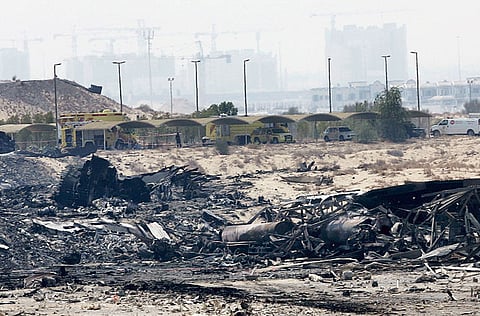Fire began in cargo hold of crashed UPS plane in Dubai
Data sent by modern system helps pinpoint origin of fire in plane that crashed in Dubai

Washington: The fire that broke out in the UPS plane that crashed and killed both pilots, appears to have begun in a cargo compartment, people familiar with the investigation said.
Investigators said they were now trying to verify which cargo aboard the Boeing 747-400 was placed just forward of the starboard wing, where the fire erupted, sources said.
Investigators said they also wanted to know if there were any lithium-ion batteries in that location. If a battery short-circuited, it could catch fire and ignite others.
The location of the fire's source was identified quickly because the plane was equipped with a sophisticated data transmission system that sent information via satellite to the company's airline operations headquarters in Louisville, Kentucky.
The transmissions were so fast that UPS' airline staff half a world away had information that the plane was in serious trouble before it crashed, sources said.
Those familiar with the investigation who discussed the preliminary findings asked not to be identified because they weren't authorised to speak publicly.
AHM system
The UPS company, formally known as United Parcel Service, is based in Atlanta, and has identified the crew members killed in the crash as Captain Doug Lampe of Louisville, Kentucky, 48; and First Officer Matthew Bell, 38, of Florida. Lampe had been with UPS since 1995. Bell had been with the company since 2006. Both flew out of UPS's Anchorage, Alaska, pilot base.
UPS spokesman Mike Mangeot said that the crashed plane had been equipped with an aeroplane health management system, Boeing's name for the transmission system. He declined to comment on the crash itself, or say what information the company had received from the plane before the accident.
AHM systems help "self-diagnose" problems in flight and alert the airline before the plane's landing, so that maintenance workers can be prepared to carry out repairs and have parts on hand. Boeing spokesman Jim Proulx said the systems were not standard on Boeing planes, but the company had been installing them on 747-400s for customers who requested them, for about five years.
Sources said among the data transmitted ahead of the crash was an alert there was a serious problem in the cargo compartment near the starboard wing.
Saif Al Suwaidi, director-general of the UAE's General Civil Aviation Authority, which is leading the crash probe, said this week that the plane's manifest indicated the 747 was carrying "general cargo". He said much of the cargo he observed at the crash site appeared to be electronic goods.
The plane's pilots also told air traffic controllers that a fire had broken out in the main compartment, and smoke was so thick they were having trouble reading their instruments, sources said.
Heavy smoke
Among the issues raised by the crash is whether the FAA should require equipment be installed in cockpits that would enable pilots to read instruments even in heavy smoke. In most modern planes that amounts to computer screens. Pilot unions have been pressing for the equipment. Aviation safety consultant Jack Casey said pilots had limited options for extinguishing a fire in a cargo compartment.
A continuously smoky fire was especially difficult to extinguish because it interfered with the pilots' ability to breathe and see well enough to fly the plane, Casey said.
Sign up for the Daily Briefing
Get the latest news and updates straight to your inbox


